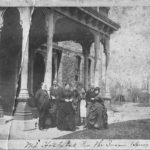Wealthy families with an insane member could usually afford to pay someone to care for their unfortunate relative; they also had accommodations for him or her. It was an entirely different matter for the poor or even the middle class, whose homes were often small and cramped by today’s standards. A working family found it almost impossible to spare an able-bodied member to care full-time for someone who was sick, whether physically or mentally. Consequently, illness of any kind sometimes drove a family into poverty, or into the dreaded poorhouse.
Poorhouses were set up to care for people who had no one else to support them. Mentally ill people with no support also wound up in poorhouses, and nobody benefited when that happened. The insane person disrupted the routine of the poorhouse and very likely frightened the other people in it. That person could get no real help, either, because a poorhouse wasn’t set up to help people with mental illness. Consequently, no one benefited from the arrangement, and the victim of insanity often suffered terribly when the poorhouse caretaker simply confined him or her to a room or an outbuilding (see last post).
One of the arguments for asylums was that jailers and poorhouse managers didn’t have the accommodations to adequately care for the insane, or the expertise to do it even if they had the space. Asylums, where trained personnel in buildings constructed specifically for keeping the insane comfortable, were supposed to be an enlightened solution to an age-old problem.








Of course, some of the people there may have been disabled, but you’re right in thinking that “elderly” back then is considered relatively young today. I’m amazed when I read in books from even the early 1900s about someone being old, only to find out that they’re about 60 or so. In that respect, I’m glad times have changed.
I came across a census for the Kings County Almshouse in 1905. What shocked me is the age range, which today is considered working age, not elderly at all. There are many in their 40s, 50s and 60s as well as truly elderly. Yikes!